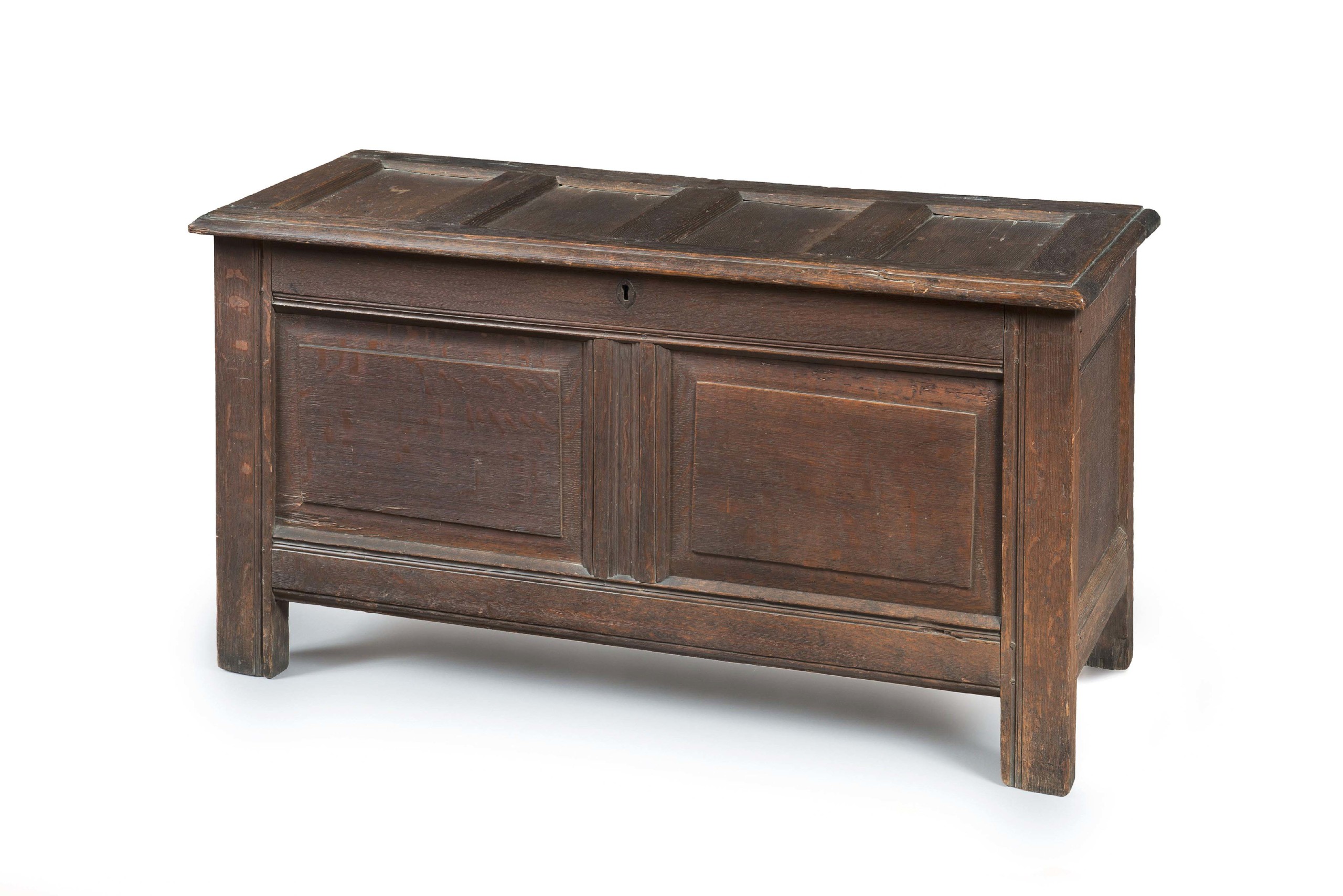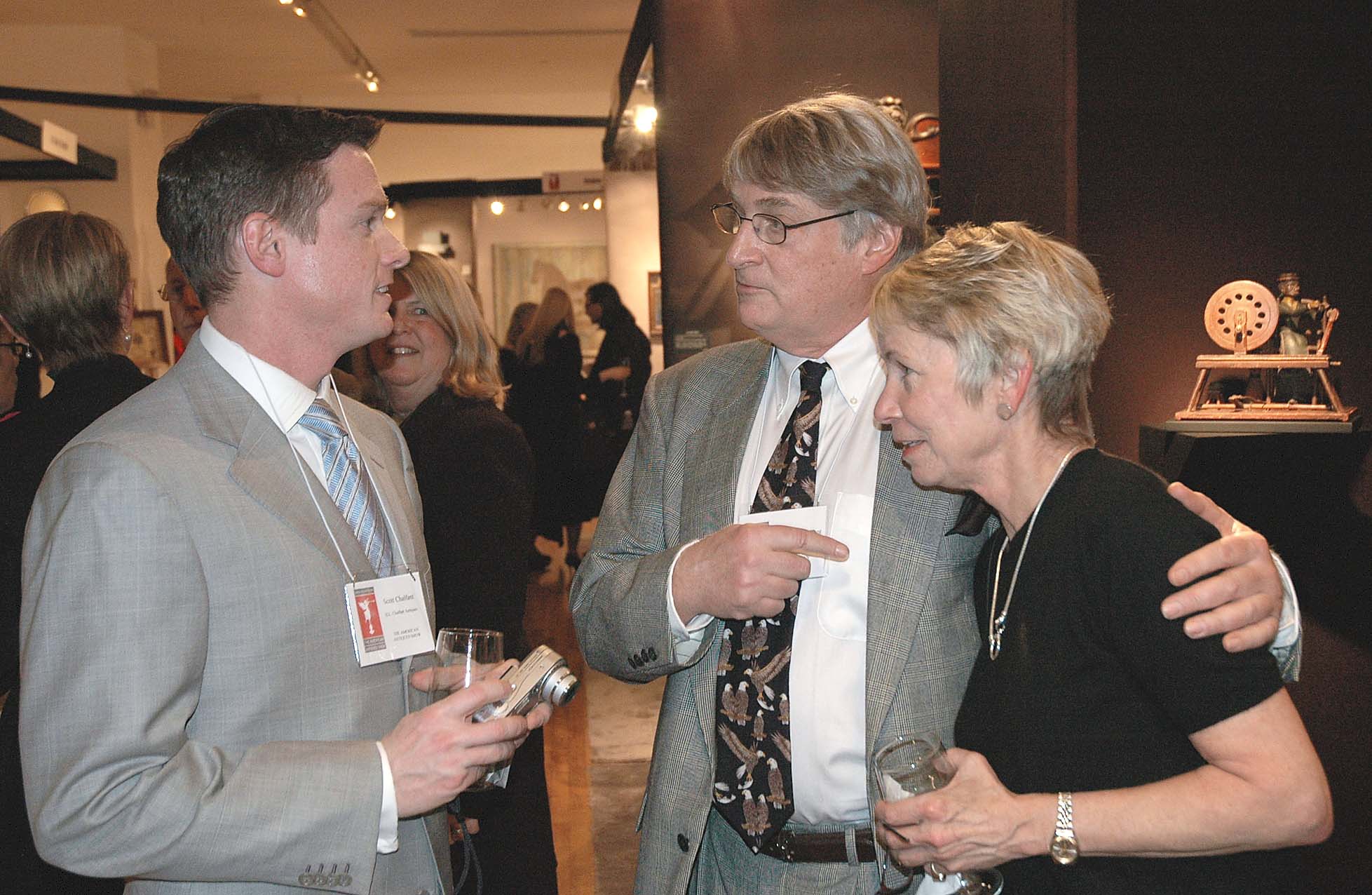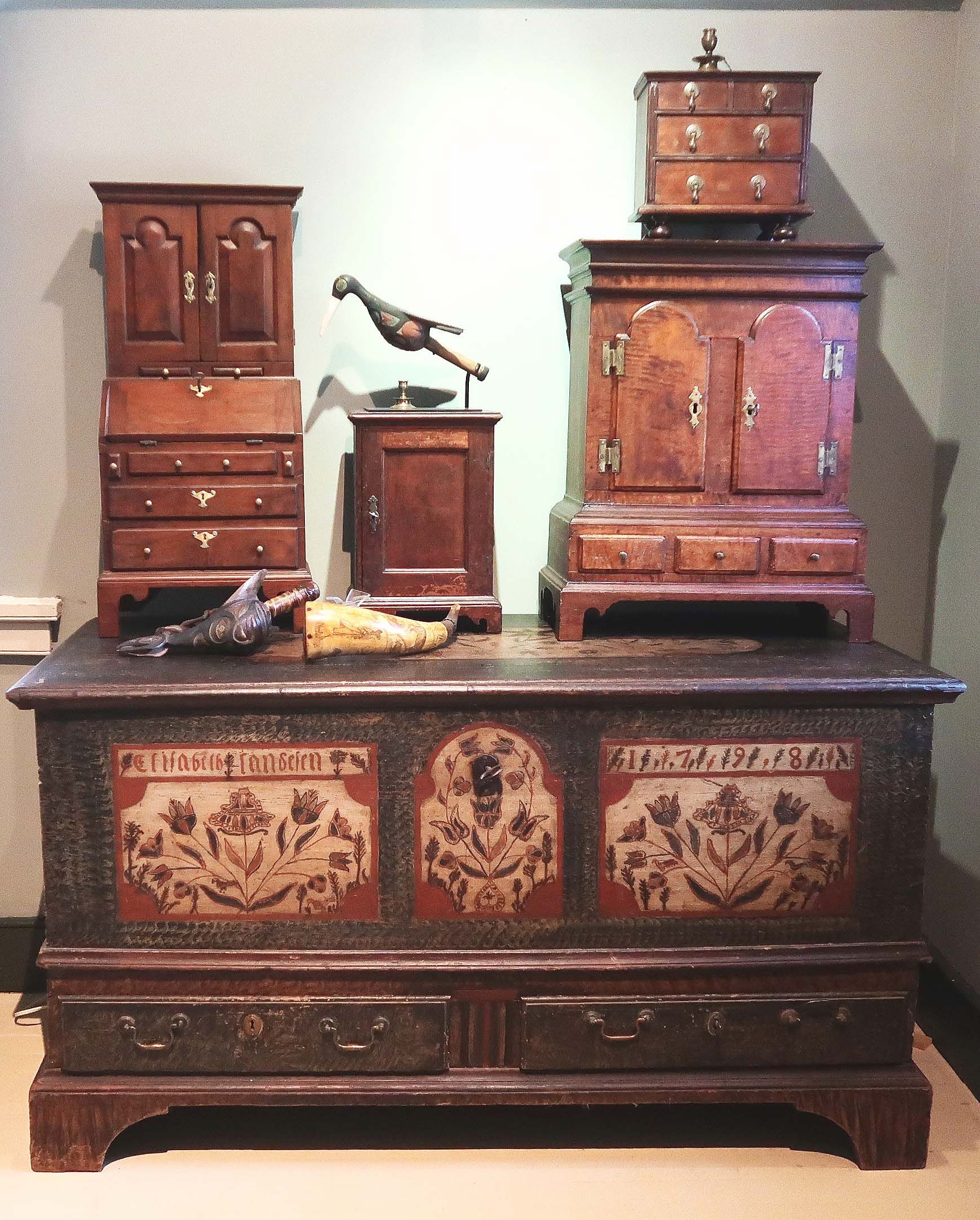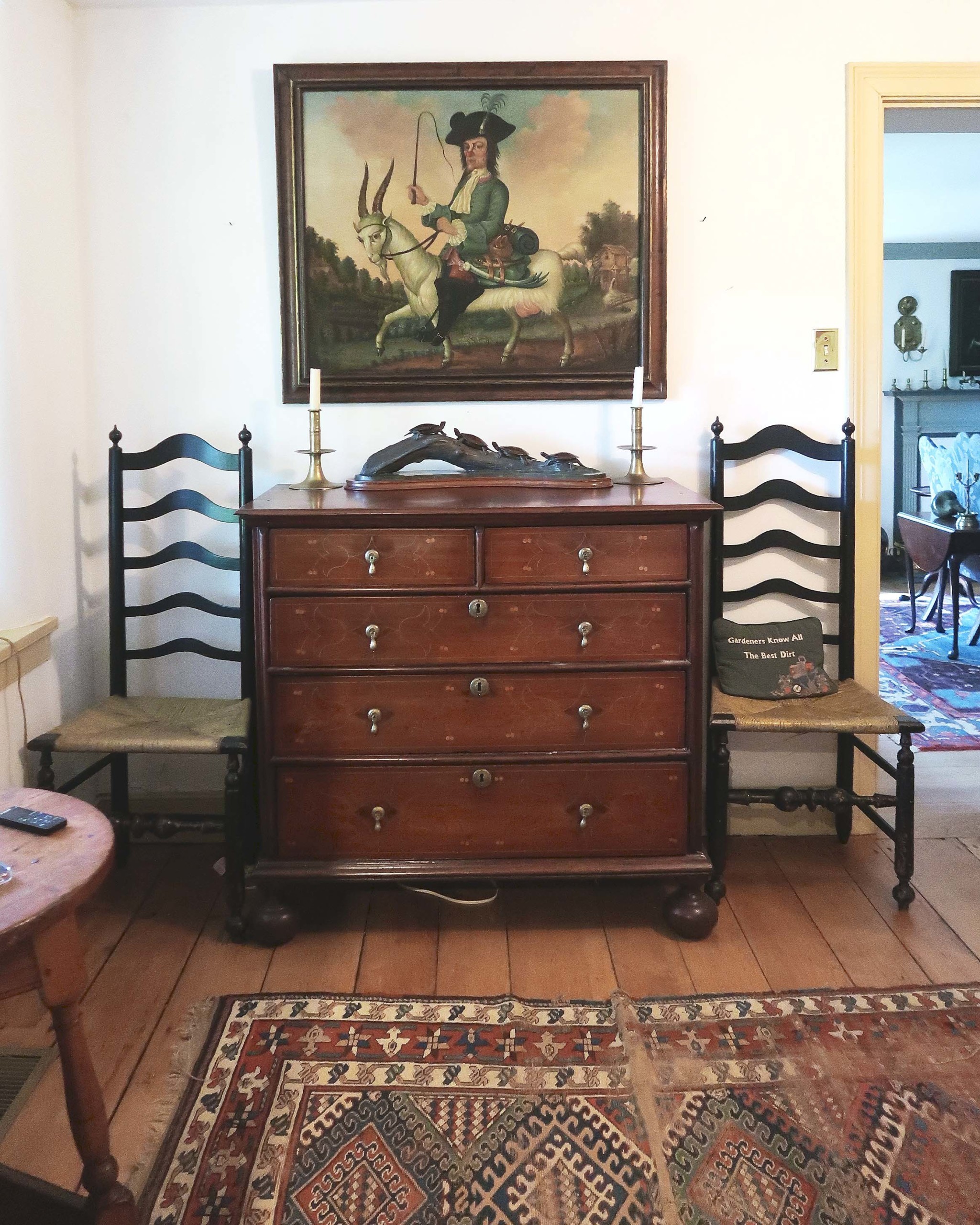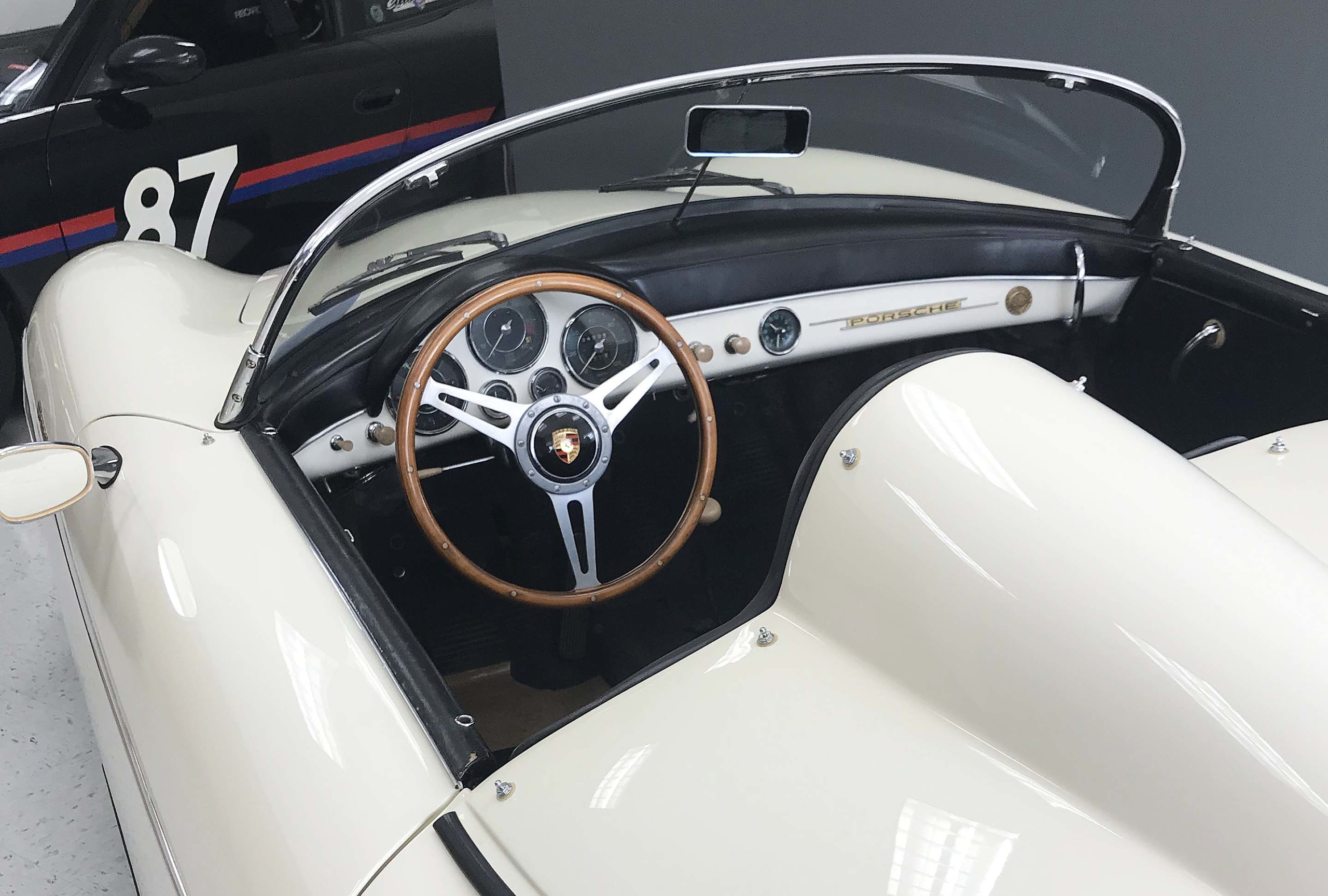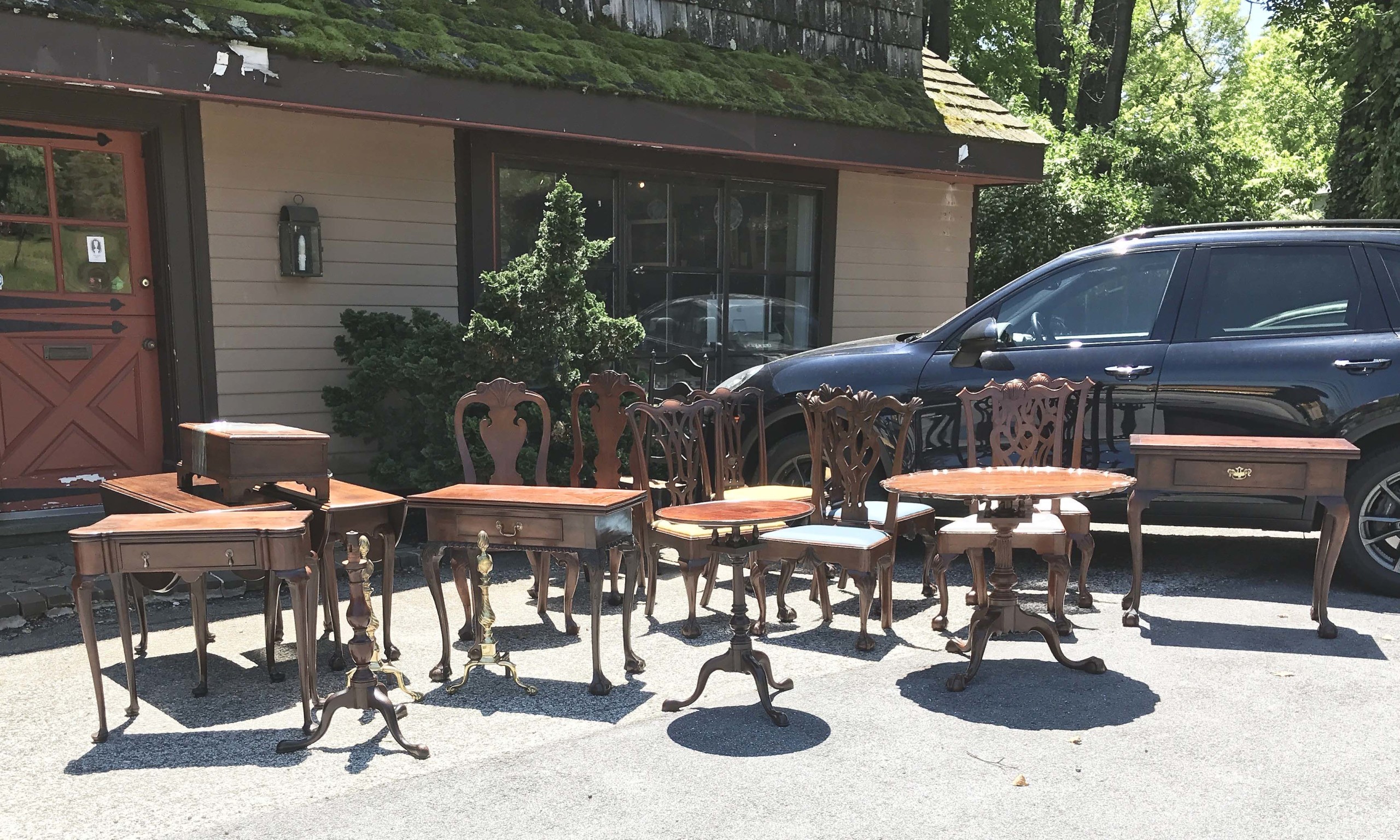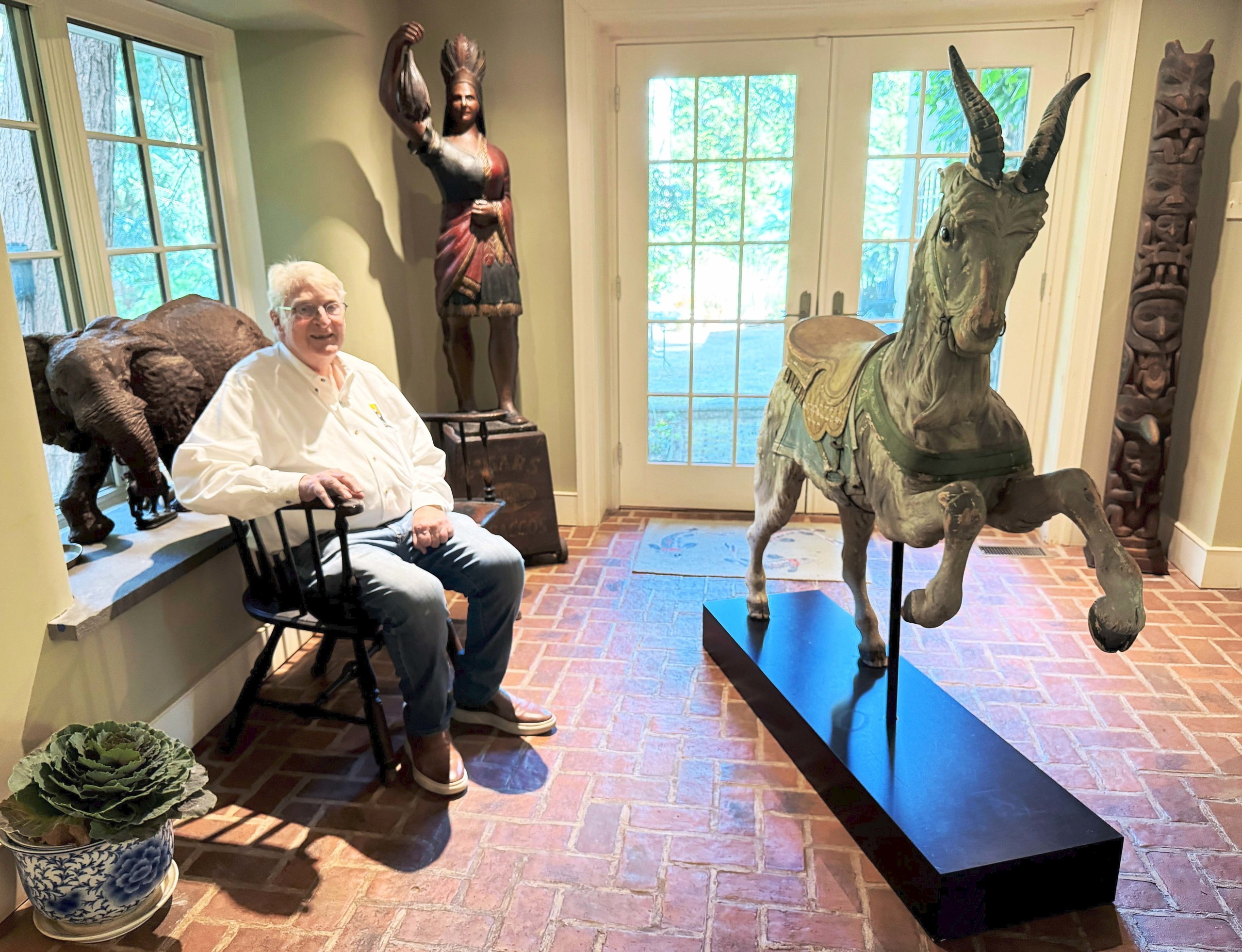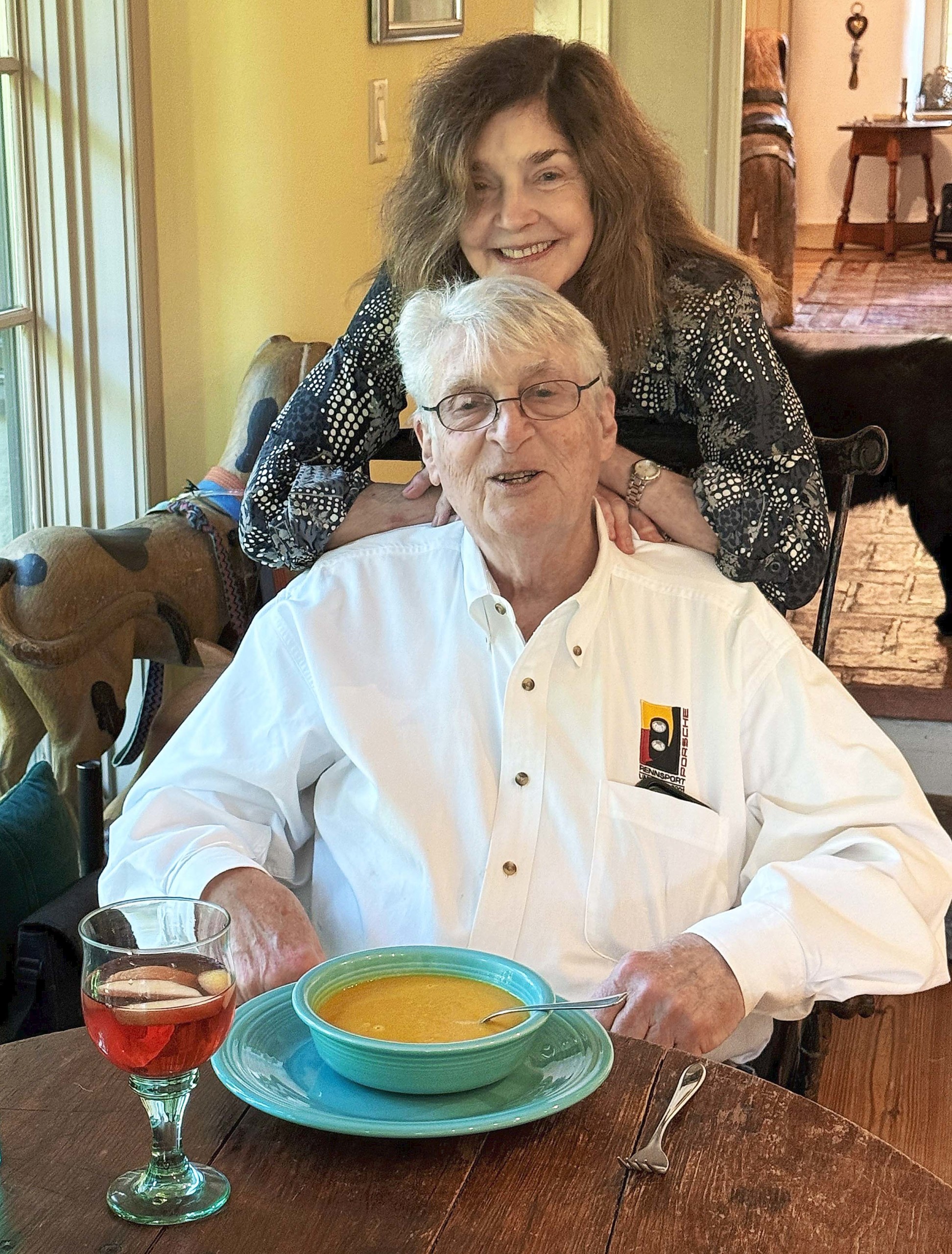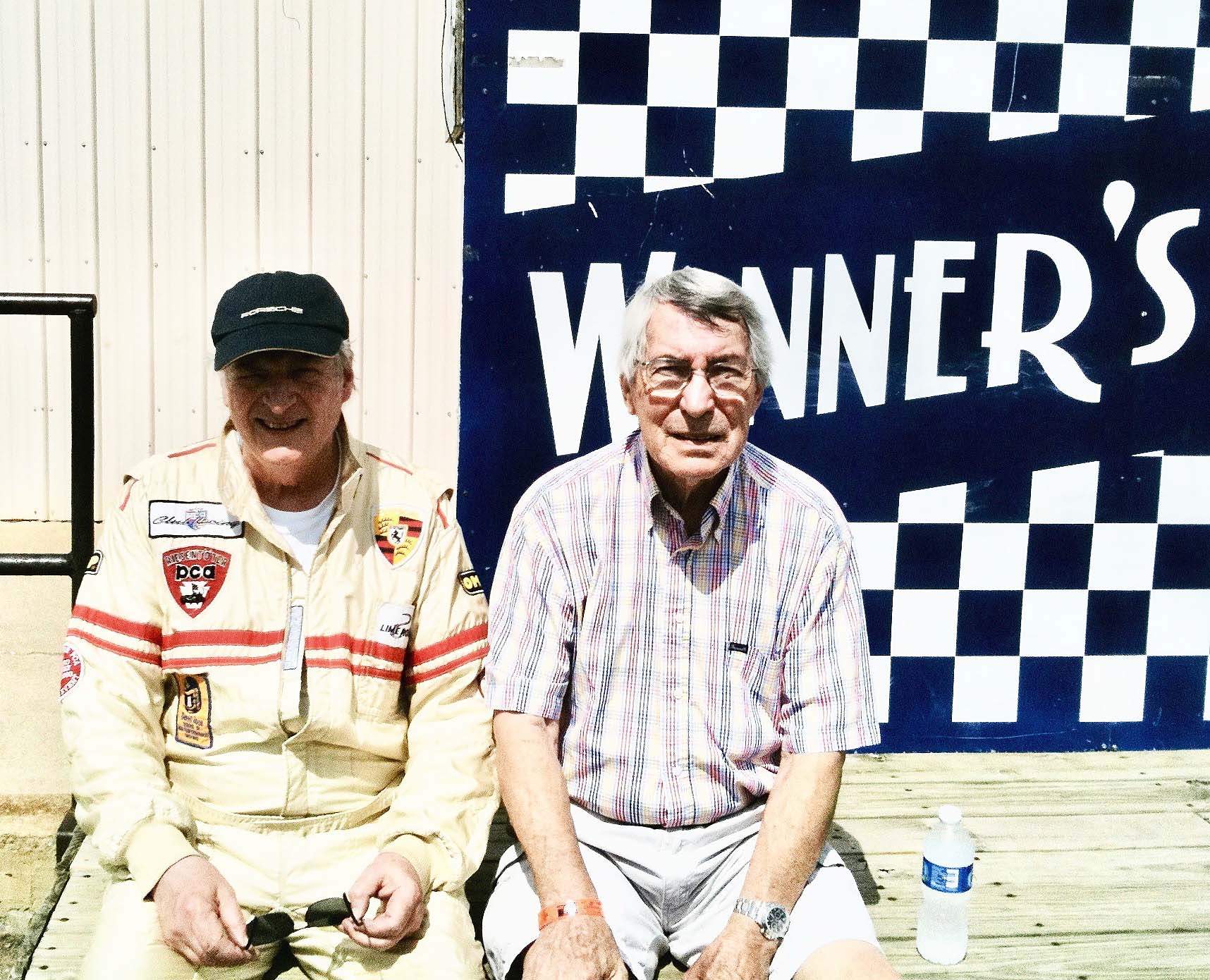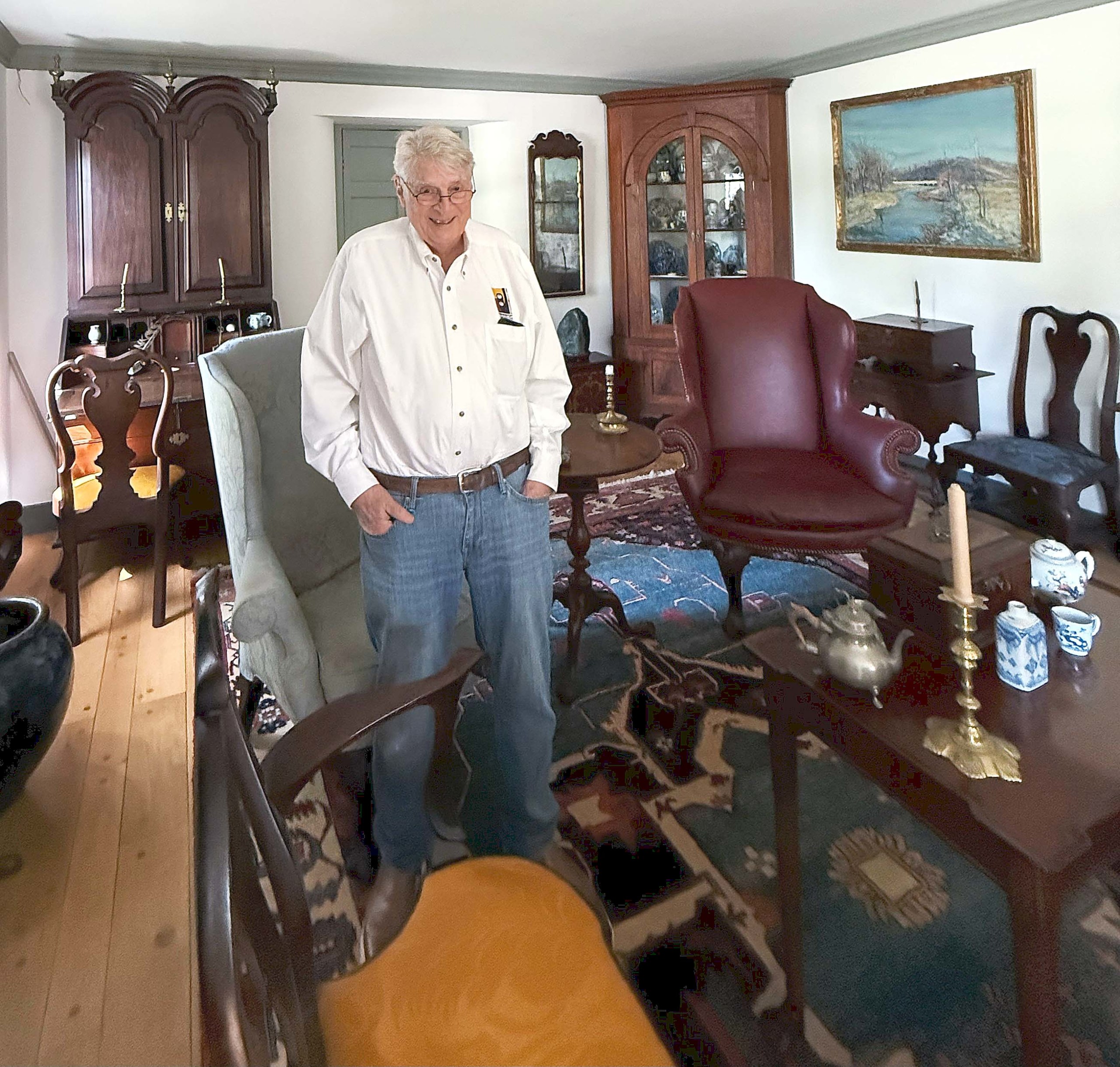
Chalfant in his formal living room. Left, a double-dome desk-and-bookcase sold by Joe Kindig, Jr & Son Antiques and auctioned by Pook & Pook in 2007 as part of the collection of Dr and Mrs Donald A. Shelley. Right, a winter landscape by Pennsylvania Impressionist Walter Emerson Baum (1884-1956). Laura Beach photo.
By Laura Beach
WEST CHESTER, PENN. — Skip Chalfant has, to borrow shamelessly from Henry David Thoreau, “traveled a good deal” in Chester County, Penn., where the dealer was born in 1943 and in 1982 opened what is now H.L. Chalfant American Art and Antiques, still in its original location. The H.L. stands for Harold Leslie, Skip’s given name, after his father.
Chalfant lives in Chester County in an old stone-and-clapboard farmhouse with a Porsche parked outside, calling to mind some romantic patricians of popular literature, from the meditative Endeavour Morse, who drove a Jaguar Mark II, to the breezy, urbane Peter Wimsey, who dashed about in a Daimler. Chalfant’s professional character is similarly sterling, colleagues say, so much so that the Antiques Dealers Association of America (ADA) is honoring the dealer with its annual Award of Merit, to be presented at a dinner in Chalfant’s honor at the Delaware Antiques Show on Friday, November 7.
Chalfant loves the art and artifacts of southeastern Pennsylvania. For all the time he has spent mining its riches he has yet to own a “Peaceable Kingdom” by Edward Hicks (1780-1849), unless you count the artful copy by contemporary artist David Guilmet that hangs in Chalfant’s house. What he has owned in quantity is superb, early furniture of the Delaware Valley, a region stretching from Philadelphia, north to New Jersey and south to Delaware and Maryland.
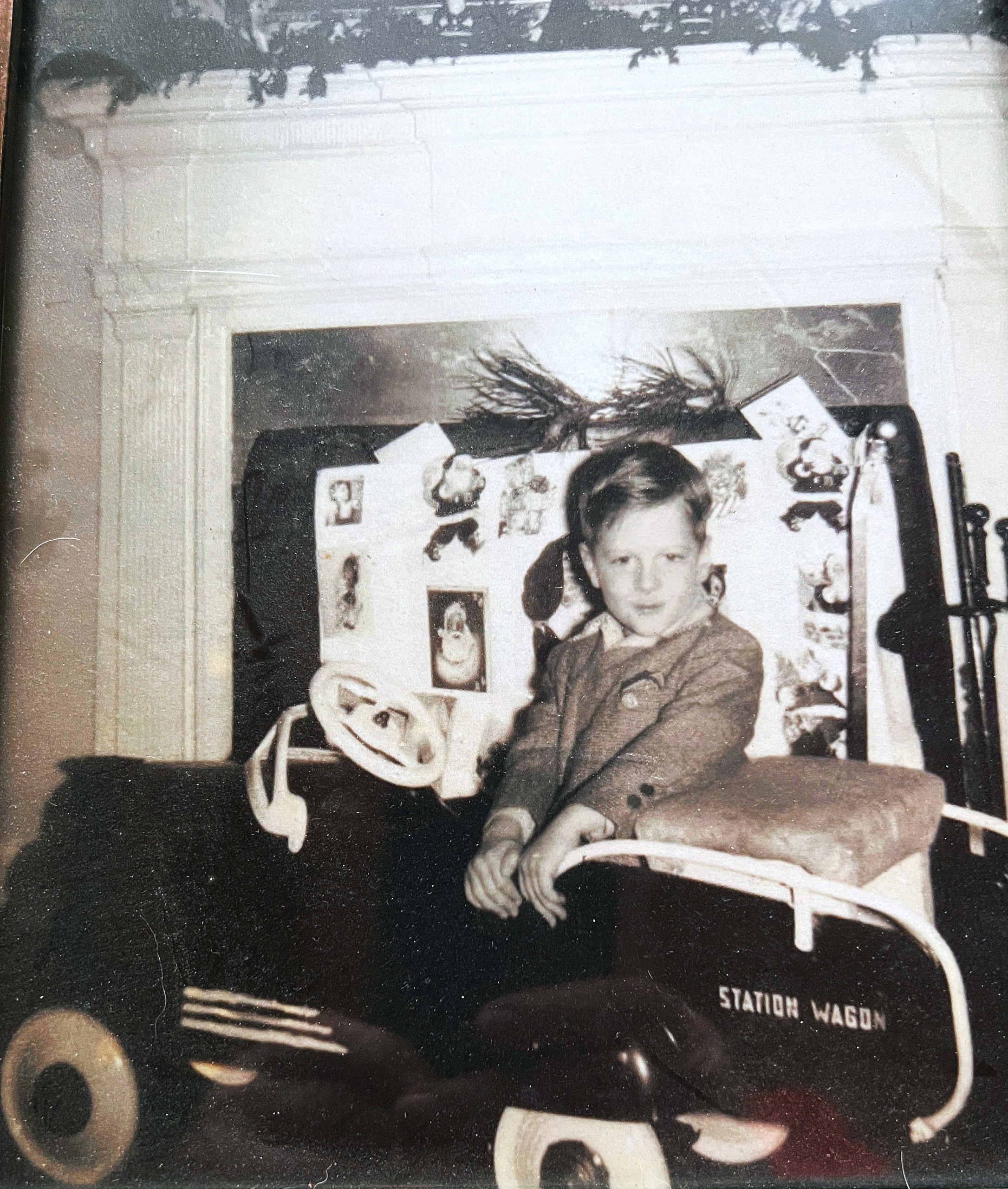
Chalfant got his first wheels, a pedal-car station wagon, for Christmas. H.L. Chalfant photo.
Chalfant is the elder son of a prosperous local dentist and his wife, Margaret Barnard Chalfant, who descended from Quakers who settled in Chester County in the 1680s and devoted much of her long life — she was Penn State’s oldest living graduate when she died at 107 in 2019, having survived her husband by 36 years — to the well-being of her family and community. He grew up with antiques — unfussy accoutrements to daily life in the Chalfant household — and a respect for the past, hearing tell of, among others, his maternal great-grandfather Enos Painter Barnard (1844-1925), a “conductor” on the Underground Railroad. The dealer’s only sibling is painter Richard Chalfant (b 1953), who captures the Brandywine region’s tumbling beauty in evocative landscapes. Jefferson David Chalfant (1861-1931), a Chester County-born painter best known for still lifes and portraits, is a distant relation.
The West Chester High School yearbook for 1961 shows Chalfant wearing a jacket and tie, his hair styled in a flattop. “Quiet until you get to know him,” its editors opined, remarking on their classmate’s “quick wit,” prowess as a runner and enthusiasm for hunting and fishing, youthful pastimes he discarded long before he and his partner of many years, Elisabeth Anderson, committed themselves to animal rights and environmental conservation.
Chalfant attended Allegheny College in Meadville, Penn., before transferring to West Chester University. Initially intent on becoming a doctor or veterinarian, he weighed his odds of being admitted to an exclusive graduate school against the more immediate threat of being drafted to serve in the Vietnam War, sidestepping the latter by taking a teaching job at the Devereux School. Furnishing his quarters, he took his mother’s advice and bought his first antique, a Classical mahogany chest of drawers, for $30.
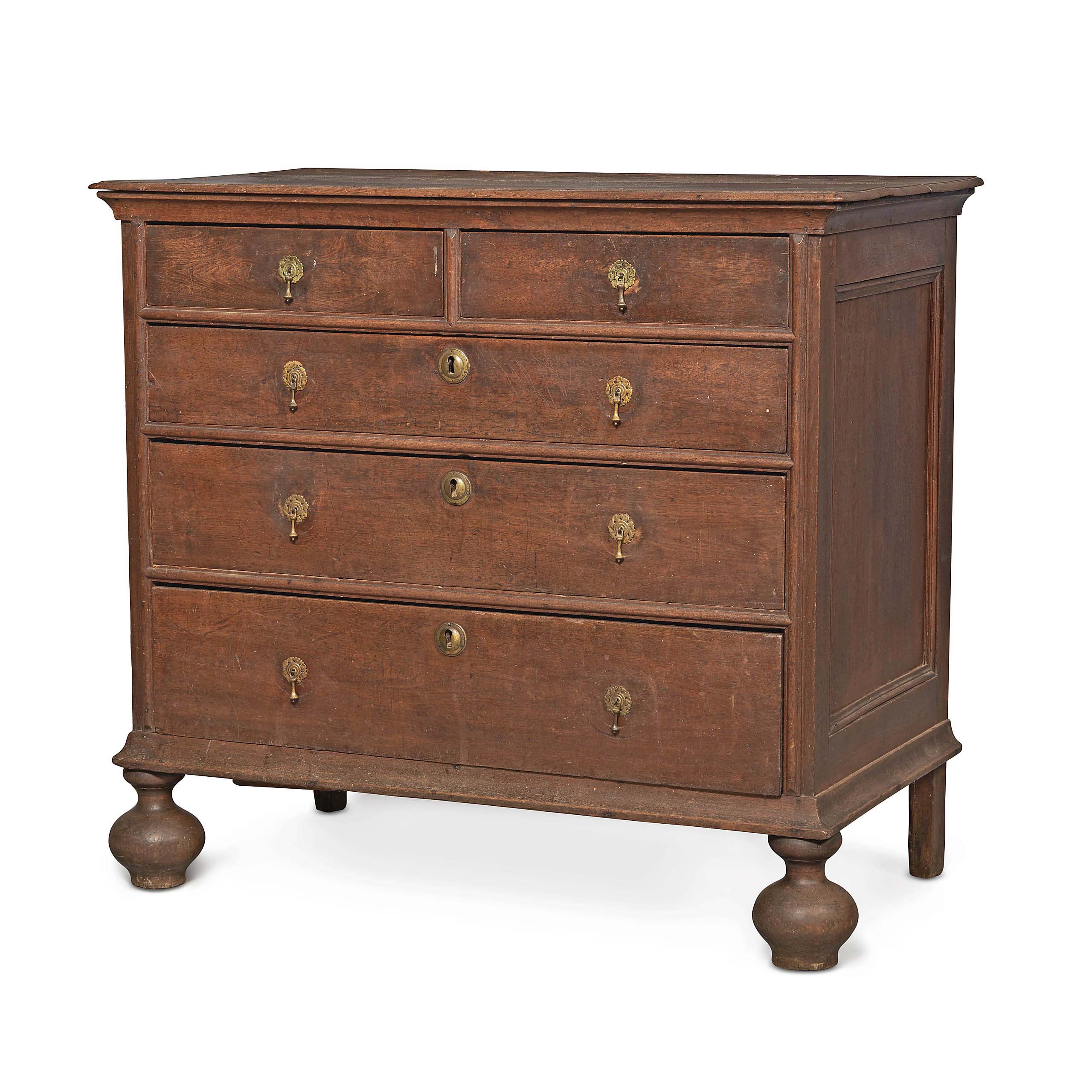
Chalfant and his colleague Dale Hunt in 1970 purchased this Pennsylvania chest of drawers on ball feet at Whiteside Auctions in Oxford, Penn., only to have their employer, Philip H. Bradley, scold them for overpaying. The discovery of a partial inscription confirmed the early Eighteenth Century piece to be the work of one of Philadelphia’s first joiners, William Beakes III (1691-1761). Subsequently owned by Bill du Pont, the chest sold at Sotheby’s in 2022 for $31,500. Sotheby’s photo.
The Downingtown, Penn., premises of Philip H. Bradley (1921-2002) hold special memories for multiple generations of dealers, some of whom got their professional start there. Collectors recall being taken to Bradley’s by a friend or relative. Antiquarians Herbert F. Schiffer and Matthew and Elisabeth Sharpe were in the area, making it possible for buyers to visit multiple shops on a Saturday outing.
Bradley was a laconic Southerner whose gentle manner belied his fierce industry. Initially interested in early glass, a taste he acquired from his mother, he established The Jug House in his Downingtown home in the early 1950s. By the 1960s, his premises on East Lancaster Avenue burst with furniture, paintings, ceramics and accessories, much of it picked from house sales and a good bit of it of regional interest. Bradley was a “dealer’s dealer” who priced fairly, sold quickly and restocked regularly.
“I was buying and selling, not quite knowing what I was doing but having a lot of fun when Phil Bradley offered me a job. I quit my teaching position and never looked back when he hired me in 1969,” Skip recalls.
He continues, “We’d cover three auctions in one weekend. There were lots of farm sales in the 1970s. The first time you saw a lot might be when the auctioneer passed it through a door or window. Bradley’s stock ranged from a $10 piece of glass to a $100,000 highboy, so you learned everything.”
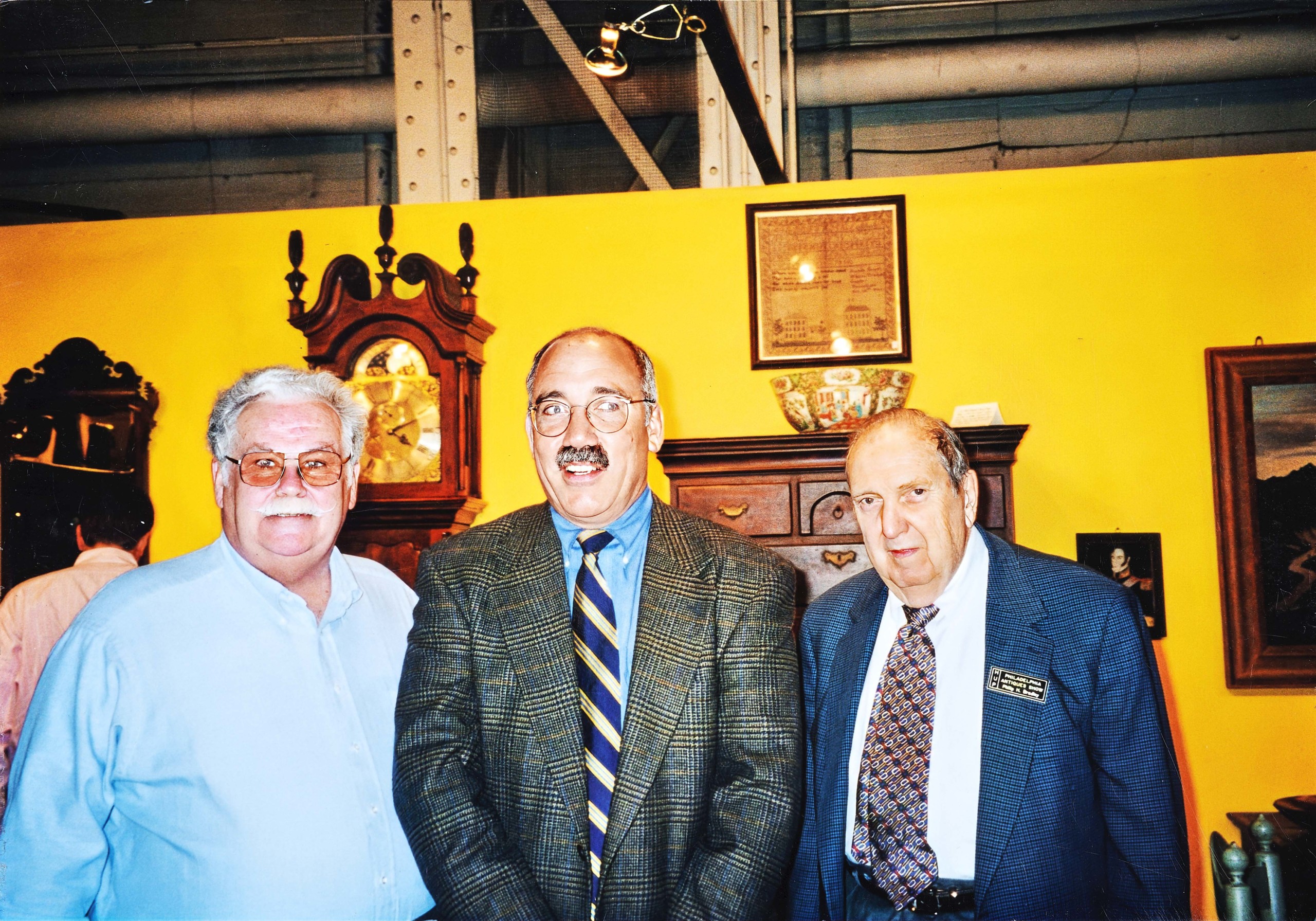
Chalfant worked for Philip H. Bradley, right, before opening his own shop in 1982. With Bradley at the Philadelphia Antiques Show is, from left, Jim Doherty, Sr, and Chalfant’s good friend Ron Pook, the Downingtown, Penn., auctioneer. Photo courtesy Lisa Minardi.
Bradley trained so many young assistants who subsequently launched their own businesses that his company was dubbed “Bradley University.” His acolytes include Dale Hunt, who started at Bradley Antiques shortly before Chalfant, along with dealers Elizabeth Matlat, Richard Worth, John Renshaw, Ben Baker, Philip Frank, Christopher Rebollo and auctioneer John Nye, among others.
Hunt, who for the past 45 years has operated the Antique Store in Wayne, Penn., notes, “Mr Bradley’s business was probably the most active of anybody’s at that time. He bought constantly, often from families. A ton of dealers stopped by all the time and we had a bunch of collectors who’d drop everything and be there in 20 minutes if you called them. It was a different world then.”
Chalfant left Bradley’s in late 1981. In early 1982, he opened Chalfant & Chalfant on Paoli Pike in West Chester with Lee Ellen Griffith, to whom he was then married. Four years later, Griffith, who retired as director of the Monmouth County Historical Association in 2012, wrote The Pennsylvania Spice Box: Paneled Doors and Secret Drawers, published by the Chester County Historical Society. The volume succeeded David H. Stockwell’s (1907-1996) October 1939 article for The Magazine Antiques, “The Spice Cabinets of Pennsylvania and New Jersey,” and research by Margaret Berwind Schiffer (1923-2022), who published Furniture and its Makers of Chester County, Pennsylvania in 1966. Griffith followed in 1988 with Line and Berry Inlaid Furniture: A Regional Craft Tradition in Pennsylvania, 1682-1790, her University of Pennsylvania dissertation topic. More recently, Wendy A. Cooper and Lisa Minardi examined Chester County furniture in their comprehensive study Paint, Pattern & People: Furniture of Southeastern Pennsylvania, 1725-1850 (2011), documenting line-and-berry furniture from the Nottingham area of Chester County.
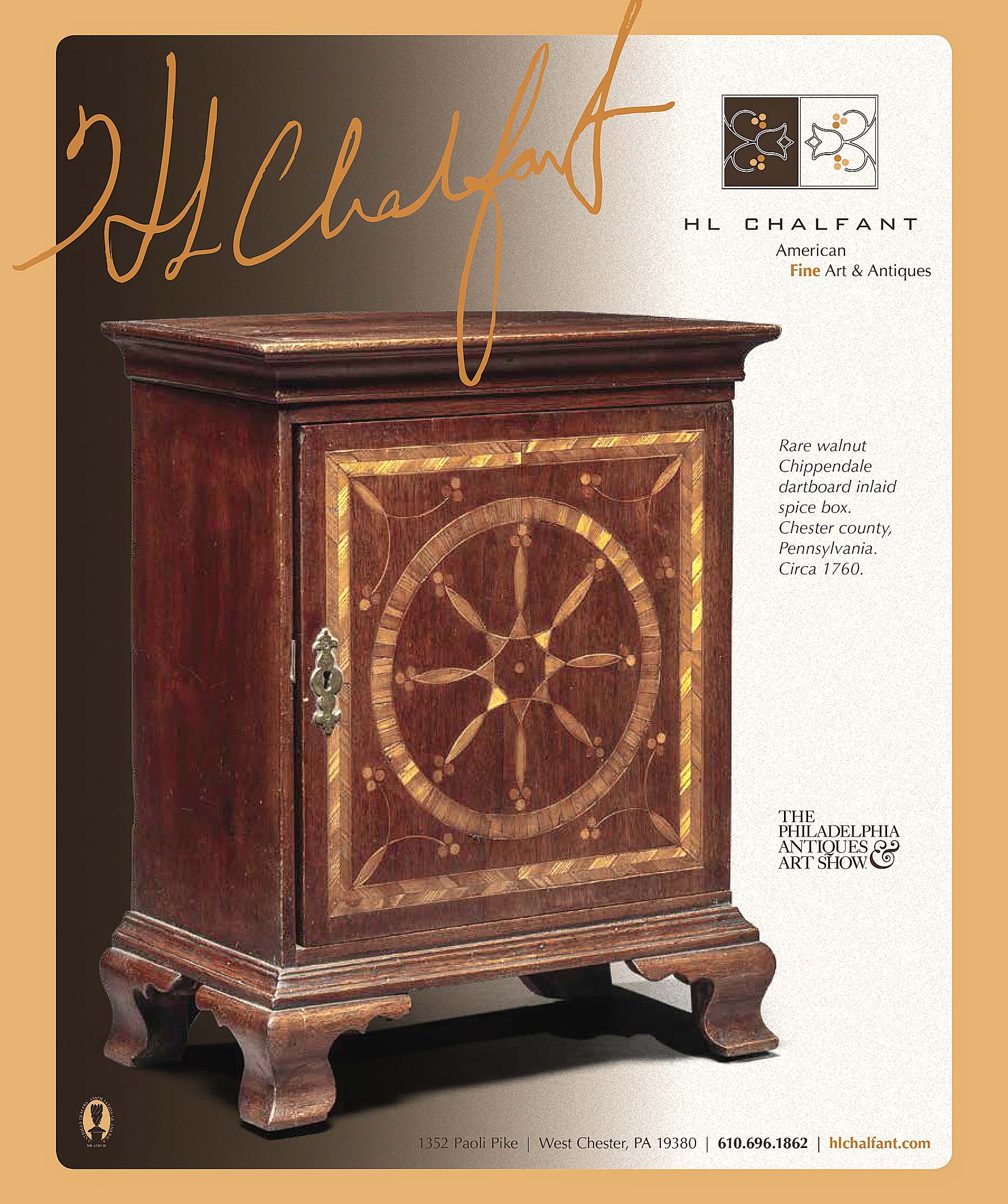
Chalfant loves spice boxes. He featured this circa 1760 Chester County example in his advertisement for the Philadelphia Antiques Show, printed in the June 2018 issue of Antiques and Fine Art. H.L. Chalfant photo.
Chalfant inherited the mantle of Chester County antiquarians before him. One early dealer of note was the Quaker farmer Francis D. Brinton (1877-1951), who with his wife, Deborah H. Brinton (1877-1960), sold to Henry Francis du Pont and gave generously to the Chester County Historical Society, now the Chester County History Center (CCHC). Deborah wrote to their patron after her husband’s death, saying, “I do hope thee can realize how many happy times thee has given us over the past years, with thy thoughtful invitations to [visit] Winterthur and Southampton, to share the pleasure of thy collections. I thank thee for everyone.”
Chalfant has long donated his time and talent to the institution, founded in 1893. He served on its board of trustees and helped launch its antiques show, which ran from 1983 to 2019. He and Wendy Cooper, Winterthur Museum curator emerita of furniture, have advised CCHC on its collections. Cooper says, “Skip and I sometimes approach objects and collections from different angles, but I’ve learned a lot from him. He’s a great person to work with. Chester County is in his blood.”
Ellen Endslow, CCHC director of collections and curator, has Chalfant on speed dial. “The first time we walked through furniture storage together he drew my attention to our unsurpassed holdings of Delaware Valley wainscot seating. I’ve worked at CCHC since 1999. If we have collectors or makers visiting, all I have to do is pick up the phone and say, ‘Hey, Skip, we’ve got a group coming. Want to join us?’ And, if he’s available, he does.”
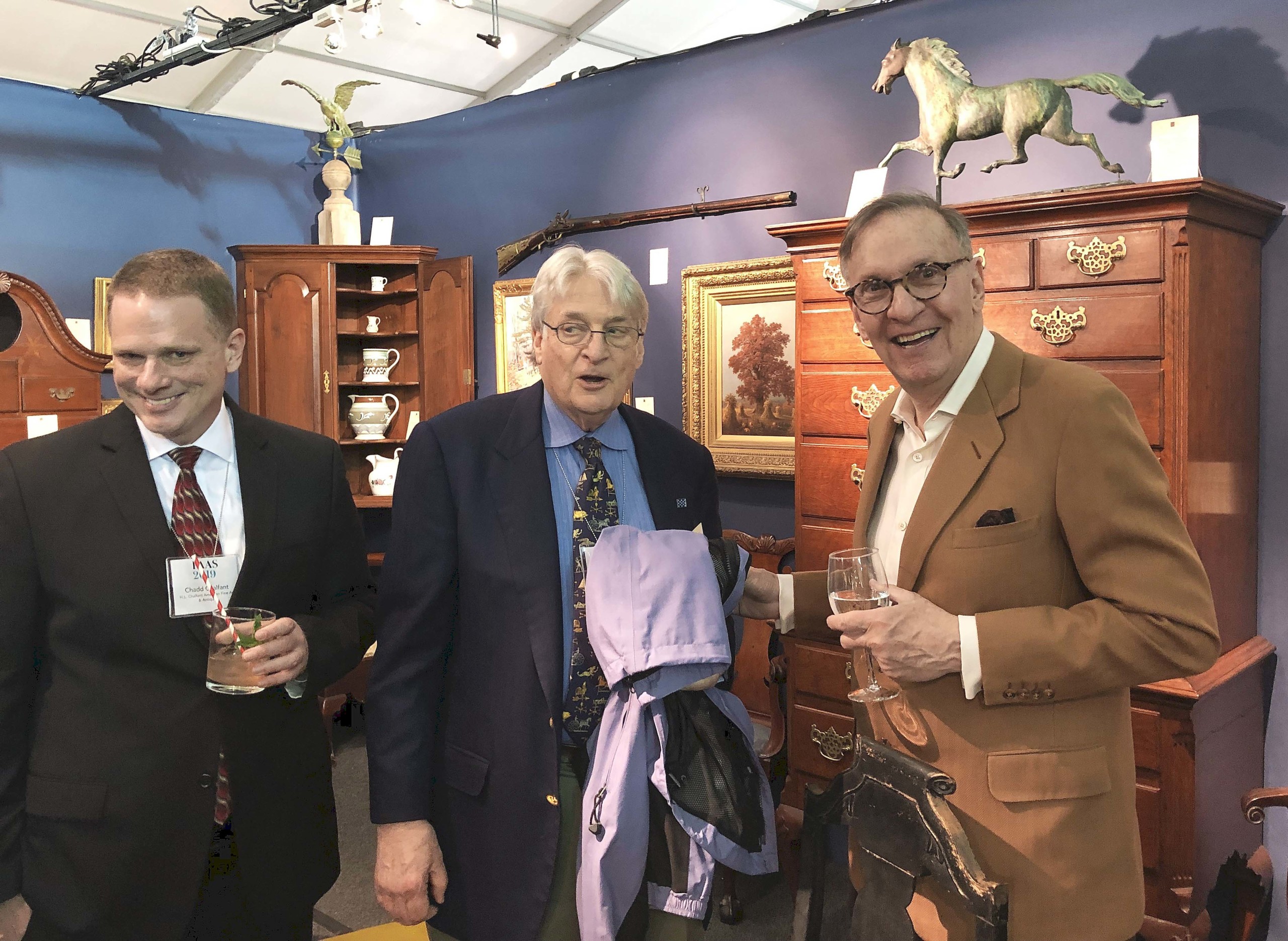
Skip Chalfant, center, was joined by his son Chadd, left, and the historian, lawyer and collector Jay Robert Stiefel, right, at the 2019 Philadelphia Show. Antiques and The Arts Weekly photo.
CCHC’s notable collection of spice boxes includes several presented by the Brintons, whose gifts to the institution, beginning in 1913, filled a ledger of more than 33 single-spaced typed pages by 1952. David Stockwell, a society dealer who started his antiques career in Brinton’s employ and initially called himself “the successor to Francis D. Brinton,” maintained a shop at 321 South High Street in West Chester early in his career. By 1946 he was operating out of a Philadelphia townhouse; that year, Stockwell wrote to H.F. du Pont, gently dismissing popular lore, saying: “often enough the so-called spice drawers give forth no spicy odor and consequently one suspects that they could not have been used for the storage of penetrating and permeating spices. Also, we find small English cabinets with more or less elaborate systems and ‘secrets’ that have a definite jewel cabinet history.”
Chalfant’s sustained interest has made him the go-to source for spice boxes and line-and-berry inlaid furniture. Details of the latter even enliven his company logo. The dealer says he has owned perhaps 25 spice boxes, some inlaid and all from Pennsylvania, noting, “Almost every du Pont house I was ever in had one or two, and in one instance I saw them stacked in a six-foot-high pyramid. The collector William K. du Pont, known as Bill, had several. CCHC has about two dozen, which is how I came to love them.” Asked what he would take with him in a fire, Chalfant responds, “Probably a spice box or two.” The dealer traded a Queen Anne Spanish-foot highboy for his favorite box, which he has owned since the 1980s. Made of walnut with holly, red cedar and locust inlay, it dates to about 1740.
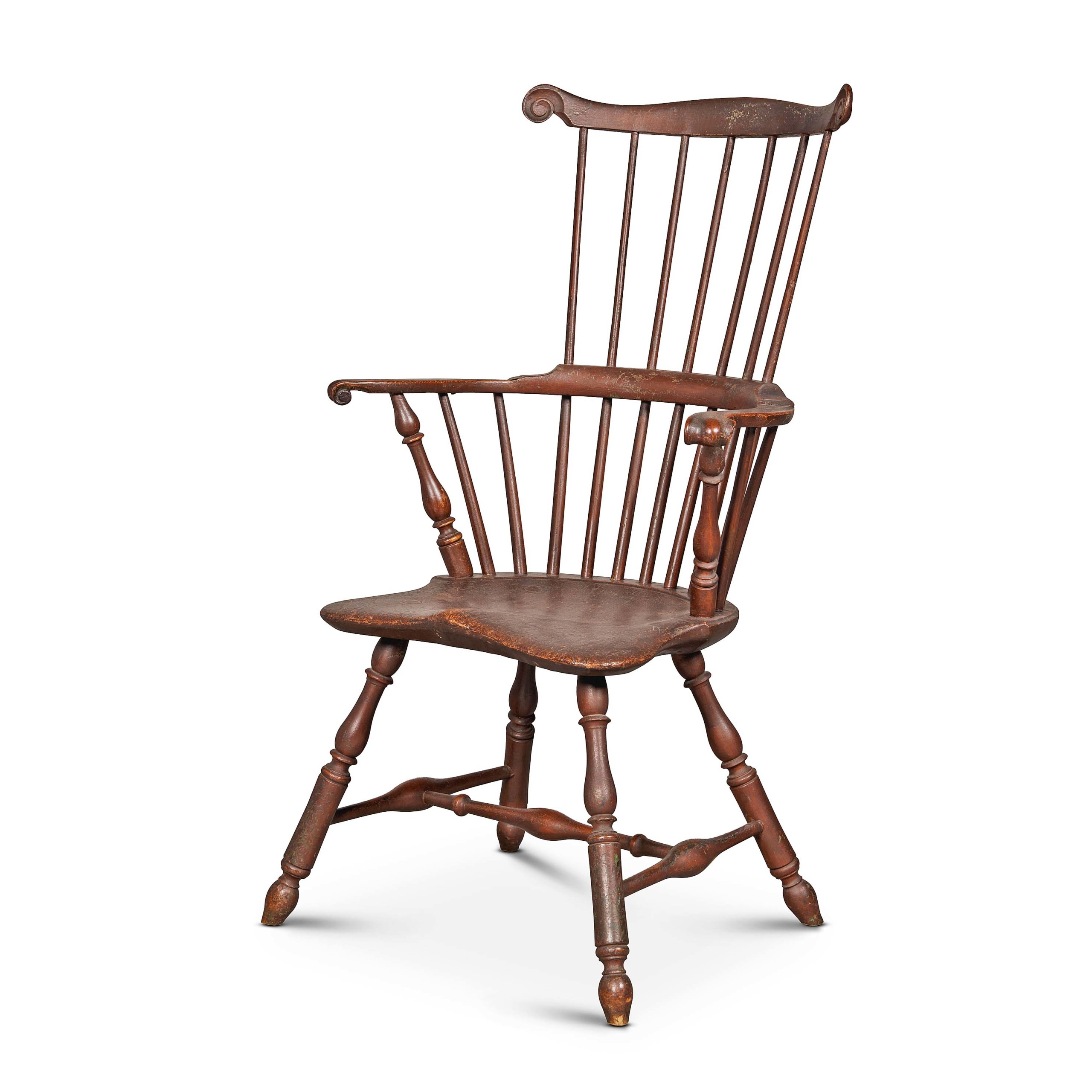
“I believe it should be considered a masterpiece of its period and of its type,” American Windsor furniture authority Charles Santore wrote of this circa 1775 Philadelphia armchair, which he acquired from Chalfant. It brought $378,000, a record at auction, at Sotheby’s in 2023. Sotheby’s photo.
Chalfant is by instinct a collector. “I buy it, fall in love with it and either take it home or just research it,” he says, noting his taste for early Pennsylvania artifacts, still relatively affordable in the 1970s. His fascination prefigured the Philadelphia Museum of Art’s 1999-2000 exhibition “Worldly Goods: The Arts of Early Pennsylvania, 1680-1758,” to which Chalfant and Bill du Pont were lenders. He made his first sale, a Philadelphia wing chair, to du Pont while in Bradley’s employ, recalling, “I took the chair to Bill’s estate, Rocky Hill, which was fantastic, with a driveway about a mile long. Bill gave me dinner and we talked antiques all night. When I got up to leave, he said, ‘By the way, consider the chair sold, but Mr Bradley has to come here and get a tour to get paid.’ Philip always preferred to be out buying. In this case, he went because the chair was a lot of money.”
As retold by Erik Gronning and James Kilvington, Chalfant and Hunt had not been at the Philip H. Bradley Company long when, in 1970, they bought an early Eighteenth Century Pennsylvania chest of drawers with paneled sides and ball feet at Whiteside Auctions in Oxford, Penn. Bradley later scolded his young staff, telling them they had overpaid. Their instincts were validated when the chalk inscription “William / Beake 171?” was discovered on the inside panel of the case, evidence suggesting the piece was made by William Beakes III (1691-1761), one of Philadelphia’s earliest joiners. In January 2022, Gronning auctioned the chest for $31,500 as part of “The William K. du Pont Collection: Important Americana from Rocky Hill” at Sotheby’s. “I have two other Beakes chests, one signed. All three are identical,” Chalfant says.
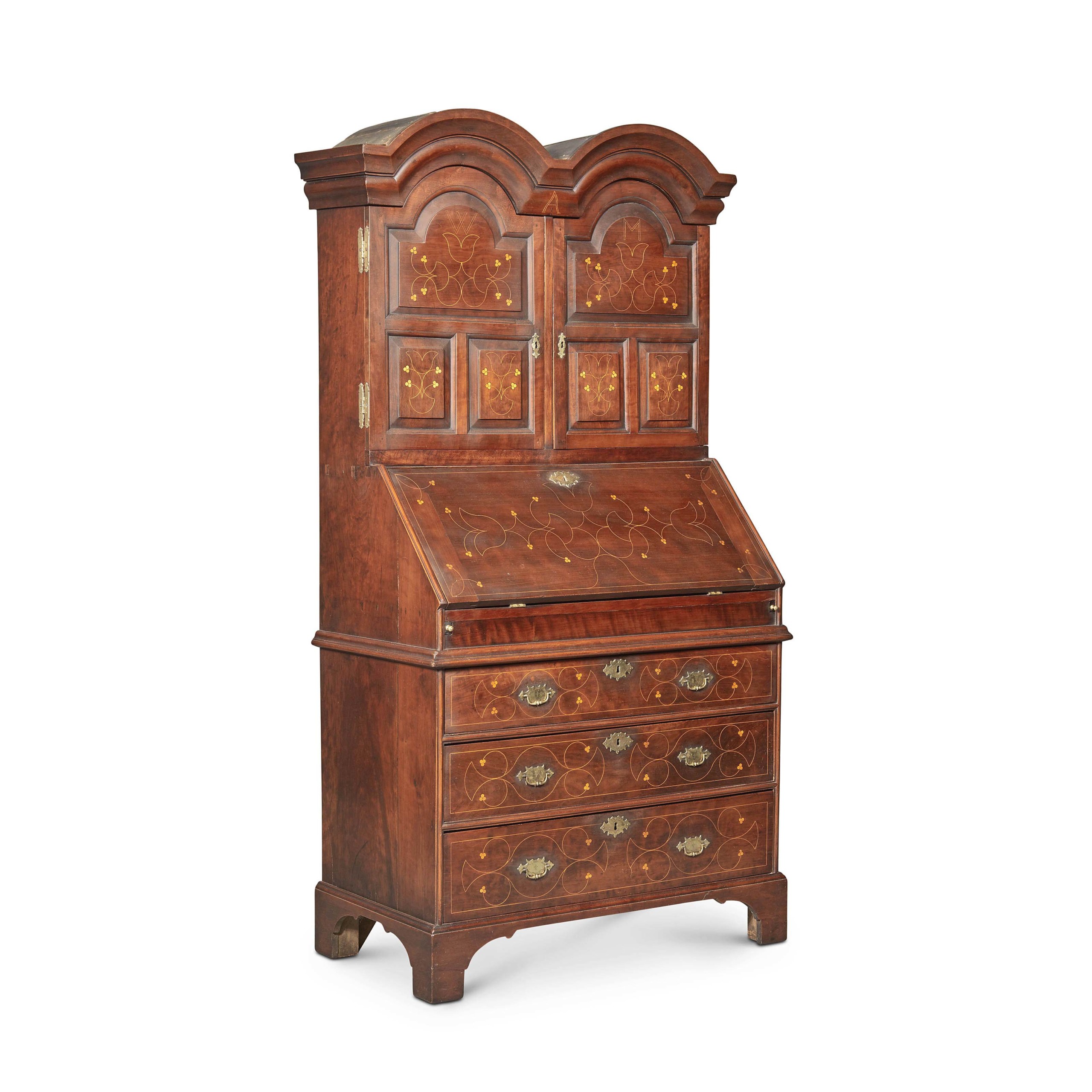
Acquired from Chalfant, this double dome-top desk-and-bookcase is said to have been Bill DuPont’s favorite piece of line-and-berry furniture. Made in the Nottingham area of Chester County around 1745, it descended in the Montgomery family before selling at Sotheby’s in January 2022 for $151,200. “I tried to buy it back but got outbid,” Chalfant says. Sotheby’s photo.
“It used to be nothing could come into our house unless it was 1750 or before, but I grew out of that,” says Chalfant, whose tastes have broadened. He and Anderson, who share their secluded property with a diffident rescue dog named Kobe and a pond full of freckled koi, love animals and are deeply committed to their welfare. A boisterous menagerie fills the rambling main house, guest house and gardens. Weathervanes take flight overhead. Carousel figures roam from the great room through the breezeway. From shorebird decoys to Northwest Coast carvings, birds are everywhere. An upstairs landing, dubbed “Squirrel Hall,” displays likenesses of the creatures, one by Susan Waters (1823-1900). Nearby are whimsical drawings of frogs by noted illustrator Charles Santore (1935-2019) and cast-bronze tree frogs by Andre Harvey (1941-2018).
It is tempting to see a parallel between the seductive curves of a Philadelphia Queen Anne chair and a sports car’s sleek contours. Chalfant has loved both since 1966, the year he bought his first Porsche, a 1958 Speedster, for $1,300. “Nothing takes a 90-degree turn faster. It sticks like glue,” he says with boyish enthusiasm on an exhilarating ride from Paoli station in his Porsche GT4. Racing was until recently a big part of his life. Starting with “parking-lot gymkhanas,” he advanced to high-profile East Coast raceways, among them Watkins Glenn International, Virginia International, Pocono, and Summit Point even occupying the track with Paul Newman at Lime Rock Park.
Chalfant shares his passion for cars with several other top Americana collectors, among them Richard Worley, whose wife, Leslie Anne Miller, documented their collecting journey in her 2014 book Start with A House, Finish with A Collection, written with Alexandra Kirtley. Miller included in the volume an exquisitely carved Philadelphia chair with scrolling open arms. Worley gave Chalfant a Porsche 928 and a check in trade for the chair. Miller, who introduced her initially skeptical husband to antiques soon after they began dating, recalls, “It was at that moment that I knew that I had Richard hooked on collecting.”
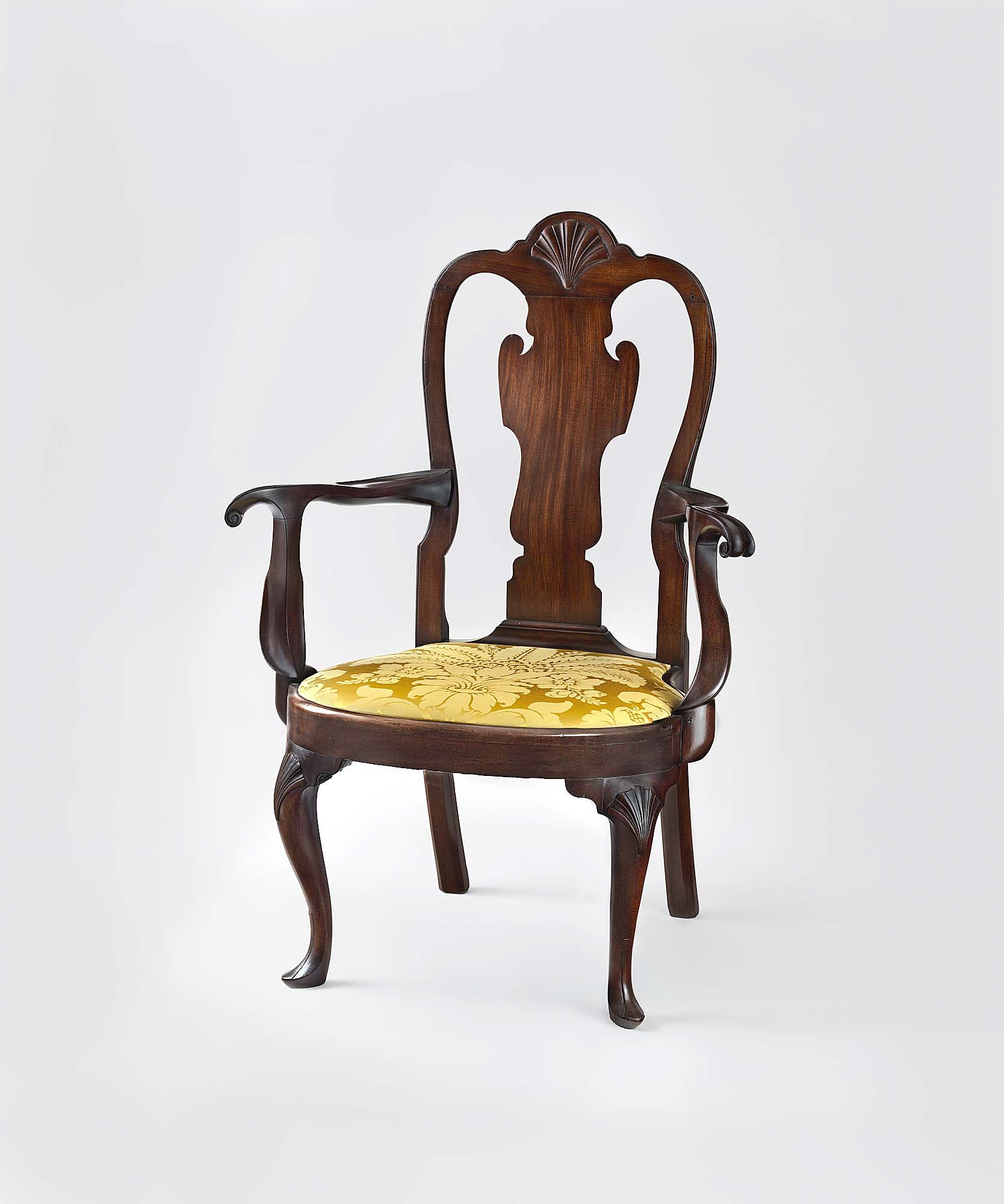
Richard Worley and Leslie Miller traded a Porsche 928 to acquire this 1740-50 Philadelphia armchair from Chalfant. The fiddle-shaped splat is made from a choice piece of striped walnut, Miller and Alexandra Kirtley wrote in Start with A House, Finish with A Collection, their 2014 book on her collecting adventure. Collection of Leslie Miller and Richard Worley. Photo Gavin Ashworth.
Helped at different times by his sons, Scott and Chadd, and his nephew Owen, Chalfant has for years juggled an open shop with shows, drawing clients to prestigious events in Philadelphia, Delaware, New York and beyond. A longtime member and two-time president of the Antiques Dealers Association of America, he says, “I joined the ADA because of its ethics. You weren’t allowed to sell bad things to people and had to be forthright in your business dealings. I believed that then and I believe it now.”
Echoing the views of colleagues, dealer and Delaware Antiques Show manager Diana Bittel says, “I wish all exhibitors were like Skip. He puts together a beautiful booth and is most pleasant to work with.”
Chalfant notes, “I was the new kid on the block when I started out. Now I’m the old man. Antiques dealing is not an easy business, but I love it. Every day is a surprise. You don’t know what will come in the door, who you will see or what you will sell. It’s a people business, and I like the people.”
The 2025 ADA Award of Merit dinner honoring Skip Chalfant is planned for Friday, November 7, at 6 pm at the Delaware Antiques Show, Chase Center on the Riverfront, 815 Justison Street in Wilmington, Del. Tickets are $95 each and include admission to the antiques show and free parking. To purchase online, www.adadealers.com.

